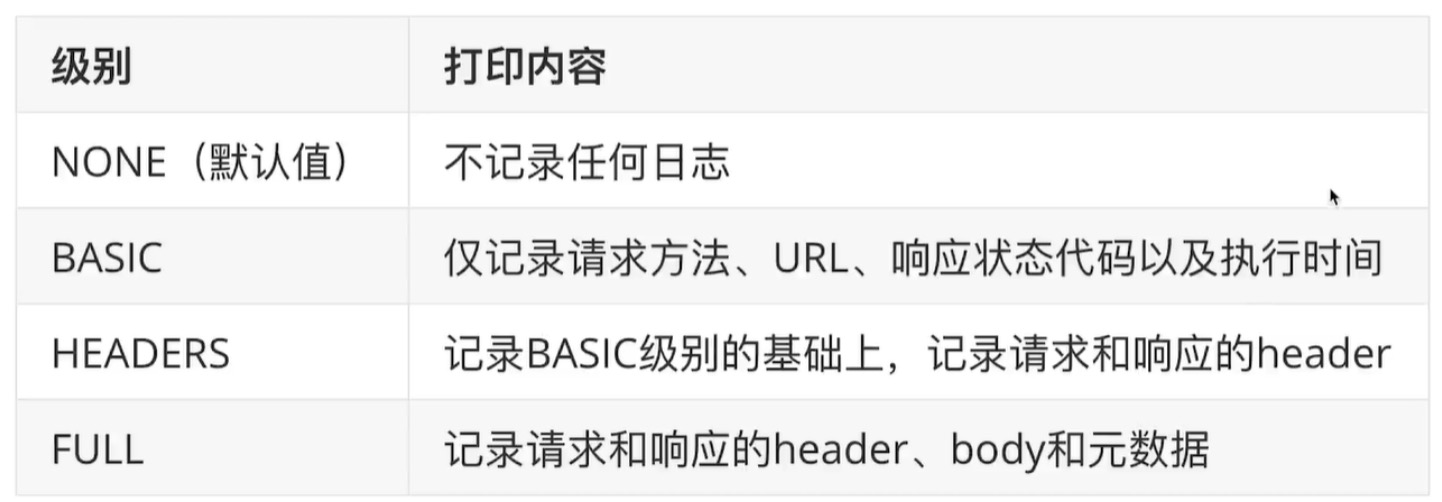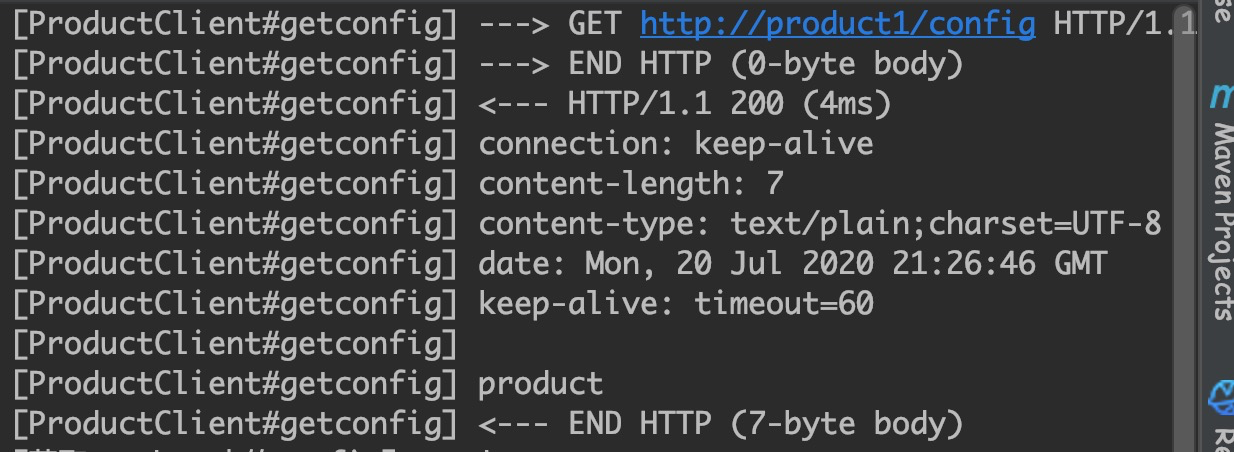一:Feign介绍
二. Ribbon VS Feign
feign和ribbon是Spring Cloud的Netflix中提供的两个实现软负载均衡的组件,Ribbon和Feign都是用于调用其他服务的,方式不同。Feign则是在Ribbon的基础上进行了一次改进,采用接口的方式。
将需要调用的其他服务的方法定义成抽象方法即可,不需要自己构建 http 请求。
不过要注意的是抽象方法的注解、方法签名要和提供服务的方法完全一致
1.启动类使用的注解不同,Ribbon 用的是@RibbonClient,Feign 用的是@EnableFeignClients。
2.服务的指定位置不同,Ribbon 是在@RibbonClient 注解上声明,Feign 则是在定义抽象方法的接口中使用@FeignClient 声明。
3.调用方式不同,Ribbon 需要自己构建 http 请求,模拟 http 请求然后使用 RestTemplate 发送给其他服务,步骤相当繁琐。
个人觉得主要原因是这个
Feign
Feign 是在 Ribbon 的基础上进行了一次改进,是一个使用起来更加方便的 HTTP 客户端。采用接口的方式, 只需要创建一个接口,然后在上面添加注解即可 ,将需要调用的其他服务的方法定义成抽象方法即可, 不需要自己构建 http 请求。然后就像是调用自身工程的方法调用,而感觉不到是调用远程方法,使得编写 客户端变得非常容易。
Ribbon
Ribbon 是一个基于 HTTP 和 TCP 客户端 的负载均衡的工具。它可以 在客户端 配置 RibbonServerList(服务端列表),使用 HttpClient 或 RestTemplate 模拟 http 请求,步骤相对繁琐。
三. 在工程中引入feign
1. 加入feign依赖
<!-- 服务之间http调用, 引入feign --> <dependency> <groupId>org.springframework.cloud</groupId> <artifactId>spring-cloud-starter-openfeign</artifactId> </dependency>
2. 添加注解
在启动类增加注解
@EnableFeignClients
3. 修改工程为普通的jar
我们即将创建的这个工程, 专门用来管理维护feign调用请求
因为该工程式一个普通的jar 不需要打可执行的jar
<build>
<plugins>
<plugin>
<groupId>org.apache.maven.plugins</groupId> 5
<artifactId>maven‐jar‐plugin</artifactId>
</plugin>
</plugins>
</build>
4. 编写声明式接口
@FeignClient(name="product‐center") publicinterfaceProductCenterFeignApi{ /** * 声明式接口,远程调用http://product‐center/selectProductInfoById/{productNo} * @param productNo * @return */ @RequestMapping("/selectProductInfoById/{productNo}") ProductInfo selectProductInfoById(@PathVariable("productNo") String productNo); }
在order项目中配置
四. 细粒度配置
4.1 设置日志打印级别

一共有4种级别:
设置日志有2种方式, 一种是配置文件, 一种是实体类. 我们两种方式都试一下
我们来试一下四种日志级别的效果
1. FULL: 记录请求和响应的header,body,元数据
第一步: 自定义一个ProductFeignConfig配置类
/** * 这个类上千万不要添加@Configuration,不然会被作为全局配置文件共享 * Created by smlz on 2019/11/22. */ class ProductFeignConfig { @Bean public Logger.Level level() { return Logger.Level.FULL; } }
注意: 这个配置类上面不要加@Configuration, 不然会被作为全局配置被所有文件共享
第二步: 在feignClient上指定configuration
@FeignClient(name = "product1", configuration = ProductFeignConfig.class) public interface ProductClient { /** * 调用product项目的config接口 * @return */ @RequestMapping("/config") String getconfig(); }
第三步: 设置配置文件,启动调试模式
这里如果不开启, 那么所有日志都不会被打印出. 也就是这里相当于一个开关, 这里设置了, 上面的自定义日志级别才会生效
logging:
level:
com:
lxl:
www: debug
第四步: 启动zuul-test-order 和zuul-test-product
第五步: 浏览器运行
http://localhost:8081/get/user

以上是日志级别为Full的时候, 打印的日志.
2 HEADERS: 记录basic的基础上, 记录请求和响应的header
这次使用配置文件的方式直接配置
第一步: 注释掉刚才的configuration配置项
@FeignClient(name = "product1" /*, configuration = ProductFeignConfig.class*/) public interface ProductClient { /** * 调用product项目的config接口 * @return */ @RequestMapping("/config") String getconfig(); }
注意红色字体, 是删除的部分
第二步: 在调用方: zuul-test-order 通过feign:client:config:微服务名称:loggerLevel: 日志级别来指定
feign:
client:
config:
product1:
loggerLevel: HEADERS
第三步: 启动zuul-test-order和zuul-test-product
第四步: 浏览器访问url
http://localhost:8081/get/user

咋一看,打印的内容和上面full的差不多, 不过,需要注意的是, 我们这里的这个请求是非常简单的get请求. 当请求的header较多, 请求类型为post的时候, 这里应该是有差别的.
3 BASIC: 仅记录请求方法, url, 响应状态码及执行时间(生产环境建议使用)
NONE: 不打印任何日志
这里就不一点点记录了, 直接看效果图
设置为basic

设置为none
没有任何日志
4.2 设置使用的注解风格
feign支持两种风格的注解, 一种是spring mvc的注解风格, 另一种是Feign原生的注解
@FeignClient(name="product‐center",configuration=ProductCenterFeignConfig.class) public interface ProductCenterFeignApi { /** * 修改锲约为Feign的 那么就可以使用默认的注解 * @param productNo * @return */ @RequestLine("GET /selectProductInfoById/{productNo}") ProductInfo selectProductInfoById(@Param("productNo") String productNo); }
上述案例使用的是feign如红色重点标出部分, 使用的是RequestLine的方法
通常我们还是使用spring mvc的更多一些, 如下:
@FeignClient(name = "product1" ) public interface ProductClient { @RequestMapping("/config") String getconfig(); }
4.3 自定义feign拦截器,实现参数的透传
第一步: 自定义拦截器, 该拦截器实现了RequestInterceptor接口
package com.lxl.www.order.interceptor; import feign.RequestInterceptor; import feign.RequestTemplate; import org.springframework.stereotype.Component; import org.springframework.web.context.request.RequestContextHolder; import org.springframework.web.context.request.ServletRequestAttributes; import javax.servlet.http.HttpServletRequest; @Component public class ProductRequestIntercept implements RequestInterceptor { @Override public void apply(RequestTemplate requestTemplate) { ServletRequestAttributes attributes = (ServletRequestAttributes) RequestContextHolder.getRequestAttributes(); HttpServletRequest request = attributes.getRequest(); String version = request.getHeader("version"); requestTemplate.header("version", version); } }
第二步: 启用自定义拦截器
在配置类中添加自定义拦截器
/** * 这个类上千万不要添加@Configuration,不然会被作为全局配置文件共享 * Created by smlz on 2019/11/22. */ class ProductFeignConfig { /*@Bean public Logger.Level level() { return Logger.Level.FULL; }*/ /*@Bean public Contract feignContract() { return new Contract.Default(); }*/
// 启用自定义拦截器 @Bean public RequestInterceptor getRequestInterceptor() { return new ProductRequestIntercept(); } }
第三步: 在order项目中写一个接口, 并打印参数version(前三步都是在order中设置)
@GetMapping("version") public String getVersion(HttpServletRequest request){ String version = request.getHeader("version"); log.info("order获取传递过来的版本号:{}", version); productClient.getconfig(); return this.config; }
第四步: 在product项目中接收version
@GetMapping("config") public String getconfig(HttpServletRequest request){ String version = request.getHeader("version"); log.info("product获取透传过来的版本号:{}", version); log.info("调用product/config, {}", 3); return this.config; }
第五步:查看运行效果


我们看到version在两个项目中传递
五. Feign调用优化方案
第一步:开启连接池配置
feign: client: config: product‐center: loggerLevel: full contract: feign.Contract.Default httpclient: #让feign底层使用HttpClient去调用 enabled: true max‐connections: 200 #最大连接数 max‐connections‐per‐route: 50 #为每个url请求设置最大连接数
第二步:调整Feign的日志级别(强烈推荐使用Basic级别的)
as